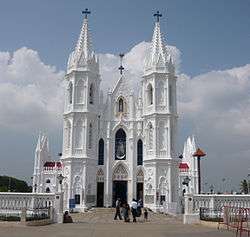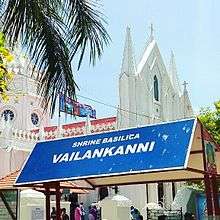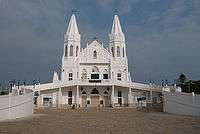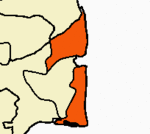Basilica of Our Lady of Good Health
| Basilica of Our Lady of Good Health | |
|---|---|
 Basilica view, facing the eastern side, Bay of Bengal | |
| 10°40′48″N 79°50′59″E / 10.68000°N 79.84972°ECoordinates: 10°40′48″N 79°50′59″E / 10.68000°N 79.84972°E | |
| Location | Velankanni, Tamil Nadu |
| Country | India |
| Denomination | Roman Catholic |
| Website | http://www.vailankannishrine.net/ |
| History | |
| Dedication | Our Lady of Good Health |
| Consecrated | 1962 |
| Architecture | |
| Status | Minor Basilica |
| Functional status | Active |
| Architectural type | Gothic |
The Basilica of Our Lady of Good Health is located at the small town of Velankanni in the state of Tamil Nadu in southern India. The Roman Catholic Latin Rite Basilica is devoted to Our Lady of Good Health. Devotion to Our Lady of Good Health of Velankanni can be traced to the mid-16th century and is attributed to three miracles at sites around where the Basilica stands: the apparition of Mary and the Christ Child to a slumbering shepherd boy, the curing of a lame buttermilk vendor, and the rescue of Portuguese sailors from a violent sea storm. These accounts are based on oral tradition and there are no written or attested records in support of them. The Holy See has not approved these apparitions.
The chapel was finally built by Portuguese sailors. More than 500 years later, the nine-day festival and celebration is still observed and draws nearly 2 million pilgrims each year. The Shrine of Our Lady of Vailankanni, also known as the "Lourdes of the East,"[1] is one of the most-frequented religious sites in India.
History
There are no historical documents or records about the apparitions of Mary at Vailankanni. Oral tradition is the source for the two apparitions of the Blessed Mother of Vailankanni in the 16th century and the saving of the Portuguese sailors from a tempest in the Bay of Bengal in the later 17th century.[2]
The first apparition is said to have occurred in May 1570, when a local shepherd boy was delivering milk to a nearby house. Along the way he met a beautiful woman holding a child, who asked for some milk for the little one. After giving her the milk, he continued on his way, and upon making the delivery discovered that the jug was now completely full of fresh, cool milk. A small shrine was built near the site where the boy encountered the woman, a location that came to be called Matha Kulam, which means Our Lady’s Pool.[3]
The second apparition is said to have happened in 1597, not far from Matha Kulam. A beautiful woman with a young boy in her arms appeared to a young crippled boy selling buttermilk. The little boy asked for some buttermilk, and after he drank it, the woman asked the boy selling buttermilk to visit a gentleman in the next town and ask him to build a chapel in her honor at that location. The boy set out quickly and realized that he was no longer lame. A small thatched chapel was quickly built in honor of Our Lady of Health, called in Tamil “Arokia Matha.” [3]
The third incident occurred when a Portuguese ship sailing from Macao to Sri Lanka was caught in a storm in the Bay of Bengal. They invoked the help of the Blessed Virgin under her title "Star of the Sea". The storm subsided and the 150 men on board were saved. It was September 8, the Feast of the Nativity of Mary. In thanksgiving, the sailors rebuilt the Shrine to Our Lady of Good Health, and continued to enhance it whenever their voyages brought them to the area.[3]

The shrine that started as a thatched chapel in the mid-sixteenth century became a parish church in 1771 when Catholics in India were under persecution from the Dutch. Later in 1962 it was granted a Special status of a Minor Basilica by Pope John XIII.[4]
The shrine of Vailankanni was elevated to the status of 'Minor Basilica' and merged with the Major Basilica of Mary (Mary majore) in Rome on 3 November 1962 by Pope John XXIII.
Significance and pilgrimage
For Goan and Konkani people, she is called "Shantadurga" (most compassionate one).[5] This especially includes use of Kotimaram, which has been described as an extended influence of Hinduism on Catholicism, thus making the Basilica a meeting point of two of the major religions of the world.[6] The portrayal of the Virgin Mary as a curer of illness and a victor over all demonic forces is seen by local Hindus as an attribute equivalent to the Hindu goddess Mariamman.[7]
Being a Roman Catholic Marian church, it is dedicated to Our Lady of Good Health. Mary is depicted wearing a sari. The usual time for pilgrimage is during the annual festival between August 29 to September 6 and Christmas.[8] Some pilgrims, instead of using a mode of transport, perform "walking pilgrimages" to it.[9] They attend mass, novenas, flag-hoisting and carry a palkhi of Mary in a procession. A major event is the procession, where only women are allowed to pull the first car and a statue of Mary is in the last and most decorated one. People of other religions also take part.[10] The pilgrims sometimes shave their heads as an offering and perform ear-piercing ceremonies, both being Hindu traditions. Another ritual considered sacred is dipping oneself in the pond. There is a holy flag which is lowered to signal the end of the festival.[11][12]
Due to the number of pilgrim visits during festival season, the Indian Railways introduced special train services to the town of Velankanni.[13]
Architecture

The Basilica is built in the Gothic style of architecture. The southern side was extended in 1928 and the northern in 1933.[14] The Shrine Basilica contains three chapels, as well as Our Lady's Tank, Church Museum, Priests' Residence, Offering Center, Stations of the Cross, Stations of the Rosary, Shrine Mega Mahal and Vailankanni Beach. The building is painted in white, except for the roof that is made of red tiles.
The early part of the 20th century marked rivalry between Jesuits and Franciscans regarding their influence on missionary work in Velankanni. In 1928, the Church of the Immaculate Heart of Mary (managed by the Jesuits) was demolished and the statues were brought to the Shrine of Our Lady of Good Health; in 1933 the Shrine was expanded with two new wings, to the right and to the left of the 'Main Altar', meeting the nave at right angles.[15]
A spacious vestry was provided immediately behind the altar. Thus the entire sacred edifice began to assume the shape of a Latin Cross. Right over the center of the ancient main altar was the miraculous image of Our Lady of Good Health.[15]
In 1956, a new welcome arch was blessed and opened by Bishop Sundaram. The illuminated arch stood to show the way to eager pilgrims who sought the protection of Mary. In January 1961, a new central altar, executed in white marble, replaced the former one made of cement concrete.[14] In 1974-75, an extension of the basilica was built behind the existing central altar to accommodate the multilingual pilgrims. The extension included a two-storied church with 93 feet (28 m) high dome and 82 feet (25 m) high gothic spirals.[15] It was designed to resemble the Basilica in Lourdes, France.[10]
List of parish priests
The basilica first became a parish in 1771.[4] The list of parish priests from 1771 till now is as follows:[15]
|
|
Gallery
-

Veilankanni - Basilica Extension
-
Veilankanni Church Pond
-
Pilgrims walking on their knees towards the Pond
-

Veilankanni - Adoration Center
-
Vailankanni Basilica
-

Vailankanni Basilica - A Panoramic Side View - Church and Church Extension seen at a stretch
-
Veilankanni Basilica - Side Left side view
-

Flag Pole at the Church
-

-

See also
References
- ↑ "Hindus join in India's Marian pilgrimage" on Catholic World News
- ↑ History of the Basilica on its home page Archived December 3, 2007, at the Wayback Machine.
- 1 2 3 Thomas, William. "Our Lady of Health, Velankanni, India", Catholic Voice, August 2, 2009
- 1 2 VAILANKANNI - an Overview on Tamil Nadu government website
- ↑ Margaret Meibohm Cultural complexity in South India: Hindu and Catholic in Marian pilgrimage University of Pennsylvania
- ↑ D. Mosse Catholic Saints and the Hindu Village Pantheon in Rural Tamil Nadu, India, Royal Anthropological Institute of Great Britain and Ireland
- ↑ Corinne G. Dempsey, Selva J. Raj Popular Christianity in India: Riting Between the Lines State University of New York press.
- ↑ "Thousands of pilgrims throng Velankanni for Christmas" news from The Hindu
- ↑ "More than 20,000 devotees walk to Velankanni ahead of flag-hoisting - Times of India". Retrieved 2016-09-13.
- 1 2 All roads lead to Velankanni on The Hindu news.
- ↑ "Melting pot: Taking a trip to Velankanni, to find solace in Mother Mary". 2016-08-29. Retrieved 2016-09-13.
- ↑ "Thousands throng Velankanni to take part in the grand car procession". The Hindu. 2016-09-08. ISSN 0971-751X. Retrieved 2016-09-13.
- ↑ "Special trains for Velankanni festival rush - Times of India". Retrieved 2016-09-13.
- 1 2 About Velankanni Archived October 9, 2007, at the Wayback Machine. on www.velankannichurch.org.
- 1 2 3 4 About Church on VelankanniChurch.com
External links
![]() Media related to Basilica of Our Lady of Good Health, Veilankanni at Wikimedia Commons
Media related to Basilica of Our Lady of Good Health, Veilankanni at Wikimedia Commons

